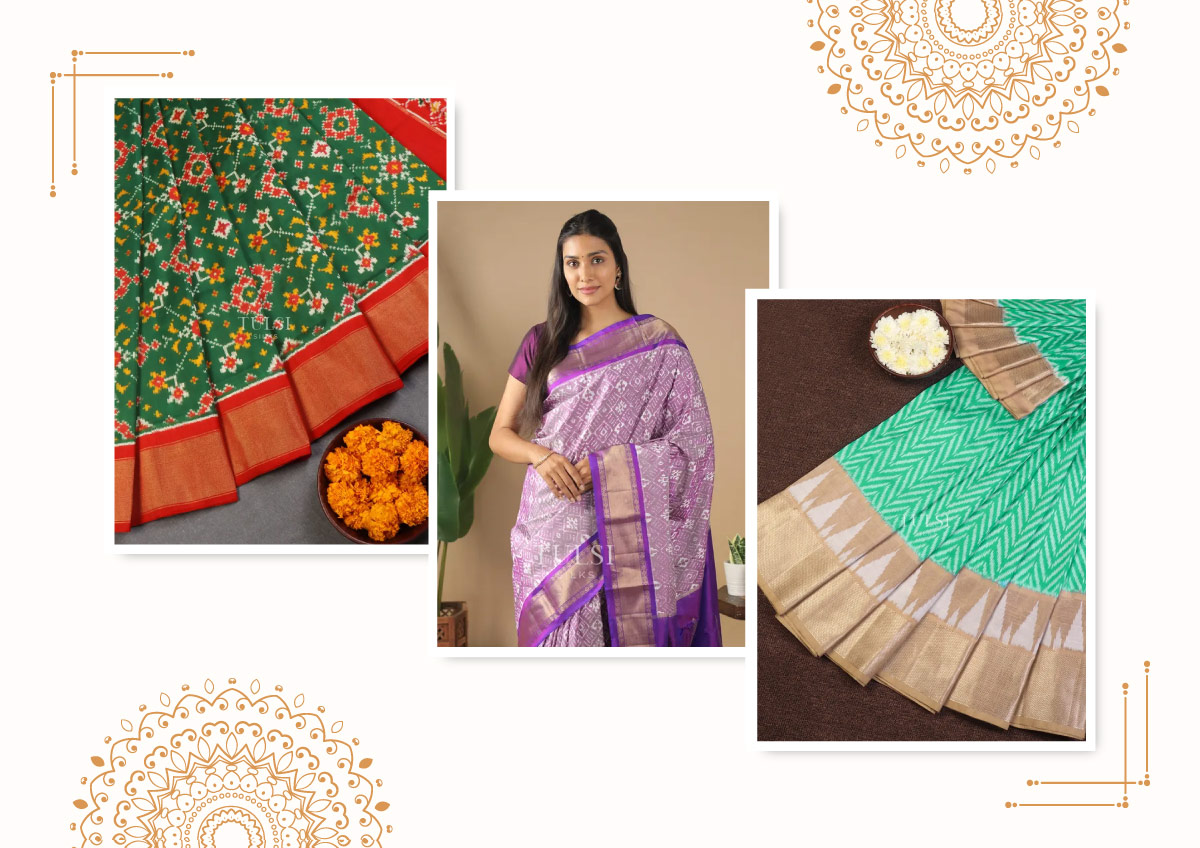Ikkat Saree Origin in India: Exploring the Rich History of Ikat Sarees
Ikkat sarees, with their striking patterns and vibrant colours, are more than just a piece of clothing; they’re a testament to India's rich weaving heritage.
Known for their intricate designs and artistic appeal, these Ikkat pattu sarees have captured the hearts of fashion lovers worldwide.
Each thread of these Ikat sarees tells us a story of craftsmanship passed down through generations, making them a unique combination of art and culture.
Want to uncover the story of Ikat Saree? You’re exactly where you need to be!
In this insightful blog post from Tulsi Silks, discover the Ikkat saree origin, history, and cultural relevance—a true reflection of India's weaving traditions.
Let's get started!
Tulsi Silks presents the finest Ikat Silk Sarees with exquisite designs. Experience elegance and craftsmanship like never before!
Suggested Read: 11 Latest Saree Trends & Outfit Styles in 2025
Ikat History & Ikat Origin in India
Ikat, a traditional form of textile weaving, has its roots deeply embedded in the cultural fabric of India. Originating centuries ago, this art form is revered for its intricate designs and vibrant patterns.
What is Ikat? Unveiling the Ikat Origin
To put it simply, Ikat means a classic, centuries-old resist-dyeing technique with deep roots in India's textile history. Derived from the Malay-Indonesian word "mengikat," the term "ikat" means "to tie or bind."
The technique involves resist dyeing threads before weaving them into the fabric, creating beautiful patterns.
Ikat weaving originated in India’s Andhra Pradesh and Odisha regions, where it became an essential part of their textile heritage.
Today, this technique is widely practised across the country, from Gujarat to the South of India.
The process begins by tightly tying parts of the yarn before dyeing it. Once dyed, the yarn is woven into the fabric, creating detailed patterns.
The Ikat weaving technique can be done with either silk or cotton yarn.
The method varies across regions, with different methods used. It is usually performed in two ways: single ikat, where only the warp or weft is dyed, and double ikat, where both the warp and weft are dyed.
Revered for its striking colours and detailed designs, ikat has a significant cultural legacy, especially in states like Odisha, Gujarat, and Andhra Pradesh (AP).
The Story of Ikat
Ikat has a long history in India, with early mentions in ancient texts. Ikat was first used to make garments for royalty and religious ceremonies. Over time, different dynasties influenced its designs.
It became a symbol of status and craftsmanship, with each region known for its unique motifs. As time passed, Ikat became more accessible. It spread across India, where local artisans added their own regional styles.
Suggested Read: Learn History of Saree, Evolution of Sarees & About Sarees in Detail
What is an Ikat Saree? Everything You Need to Know About Ikat Sarees
Ikat sarees are woven with a rich history and unique artistry that make them unique among other traditional Indian sarees.
Here's everything you need to know about Ikat sarees.
Ikat Dyeing Technique
- The core of Ikat sarees lies in the dyeing process.
- Unlike traditional methods, the yarn is tie-dyed in sections before being woven into fabric.
- The threads are tightly bound in specific areas and then dyed with different colours, resulting in the characteristic blurred edges and unique patterns when woven.
Patterns and Designs
- Ikkat sarees are known for their vibrant, geometric, and abstract patterns.
- These patterns can range from floral motifs to abstract lines, making each saree unique.
- The design is visible on both sides of the fabric, which gives the saree a reversible nature.
- The intricate designs require skilled craftsmanship and patience, making Ikat sarees a piece of art.
Symbolism in Ikat Designs
- The patterns and colours found in Ikat sarees often carry deep cultural and spiritual meanings.
- For instance, geometric shapes may symbolise balance and harmony, while floral patterns are often seen as representations of nature's beauty and fertility.
- Abstract motifs can reflect the region’s history or folklore.
- In some cultures, the designs are considered auspicious and are believed to bring prosperity, good luck, and positive energy to the wearer.
Fabric and Comfort
- Ikat sarees are typically made from silk or cotton, providing a perfect balance between comfort and elegance.
- The silk versions are often seen in more formal settings, while cotton Ikat sarees are perfect for casual wear or summer seasons.
- These sarees offer breathability and are comfortable to drape for long hours.
Major Regional Variations of Ikkat Sarees: Pochampally, Patan & Odisha
1. Pochampally Ikkat Sarees (Telangana/Andhra Pradesh)
Pochampally, located in Telangana, is renowned for its vibrant Ikkat sarees, known for geometric patterns and precise artistry. These types of Ikkat sarees are woven from cotton, silk, and silk-cotton blends, featuring motifs from florals to abstract designs. They are popular for festivals and weddings, reflecting the region’s cultural richness.
2. Patan Patola Ikkat Sarees (Gujarat)
Patan Patola Ikat sarees from Gujarat are considered some of India’s finest Ikkat creations. The double Ikkat technique, where both warp and weft threads are dyed, creates intricate geometric patterns such as diamonds and floral motifs. These luxurious Ikkat pattu sarees are highly labour-intensive and symbolise sophistication and elegance.
3. Bandha Ikkat Sarees (Odisha)
In Odisha, Ikkat sarees are known as Bandha, traditionally made using silk. Bandha Ikkat silk sarees are distinguished by rich, vibrant colours and intricate floral and paisley motifs, achieved through natural dyes. Worn during religious ceremonies and weddings, these Ikat pattu sarees hold deep cultural significance and are highly valued for their craftsmanship.
Different Types of Ikat Sarees for Every Occasion
1. Ikat Silk Sarees
Luxurious silk fabric combined with vibrant ikat patterns is ideal for festive occasions, offering both elegance and tradition.
Discover the exquisite collection of Ikat silk sarees at Tulsi Silks. Perfect for festive occasions. Shop now and elevate your style!
2. Patola Ikat
Gujarat's double ikat weaving technique features intricate geometric patterns and vibrant colours, making it highly coveted and luxurious.
3. Pochampally Ikat
Telangana's vibrant double ikat weaving creates stunning geometric patterns, known for their bold colours and intricate craftsmanship.
4. Bengal Ikat
West Bengal's ikat sarees are characterised by subtle, flowing patterns and a softer, more delicate colour palette.
5. Orissa Ikat
Known for nature-inspired motifs, Orissa Ikat sarees are woven with precision, showcasing traditional techniques and cultural richness.
6. Kalamkari Ikat
A fusion of ikat weaving and hand-painted Kalamkari art, creating sarees adorned with intricate, detailed artistic designs.
7. Ikat Cotton Sarees
Comfortable, breathable cotton fabric featuring traditional ikat designs is perfect for casual, everyday wear with a cultural touch.
Suggested Read: 14 Different Types of Traditional Sarees of Different States in India
Wrapping Up,
In conclusion, the Ikat saree origin is a reflection of India’s rich textile heritage, with its roots deeply embedded in the weaving traditions of regions.
The Ikat origin in India traces back centuries, where the unique technique of resist-dyeing yarn before weaving gave birth to the intricate patterns that define Ikat sarees today.
This art form has evolved through generations, maintaining its cultural relevance and appeal.
As Ikat sarees continue to captivate the fashion world, they remain not just garments but representations of India’s vibrant weaving traditions.
Looking for exquisite Ikat silk sarees?
Tulsi Silks offers vibrant colours, intricate designs, and premium quality.
Shop online for a stunning collection of Ikat pattu sarees or visit our Mylapore store for an exclusive in-store experience.
Get inspired by the latest saree trends and styles—check out our blog section right now!




